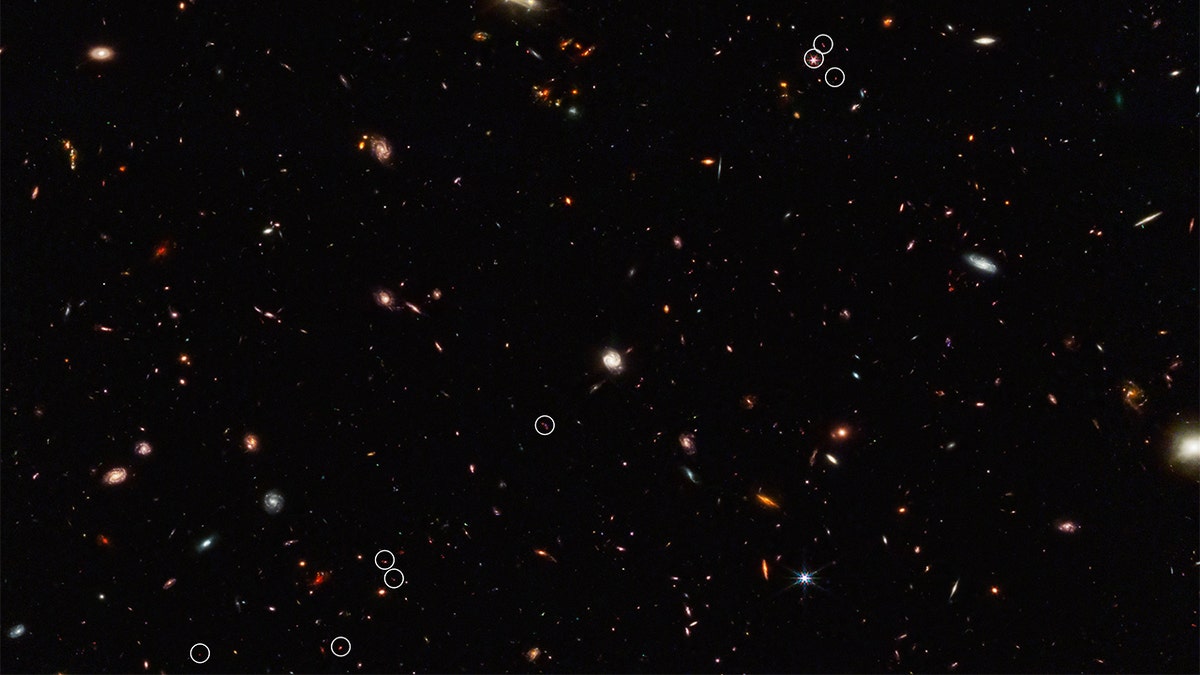Webb Space Telescope allows us to 'look into the past': Theoretical physicist
Theoretical physicist Dr. Michio Kaku explains the significance of new images provided by NASA's Webb Space Telescope on 'Sunday Night in America.'
Astronomers have used NASA’s James Webb Space Telescope to identify a string of 10 galaxies appearing to be connected by a thread, which they say existed 830 million years after the Big Bang.
On Thursday, NASA said on its website that galaxies gather in clusters, but also into "vast interconnected filamentary structures with gigantic barren voids in between."
The cosmic web that astronomers recently discovered was pulled together by gravity over time, making it more distinct.
JAMES WEBB SPACE TELESCOPE DETECTS NEW CARBON COMPOUND IN SPACE FOR THE FIRST TIME

Webbs Near-Infrared Camera captured a deep galaxy field, showing eight circled galaxies in line with one another. Some of the circles contain multiple galaxies, according to NASA. (NASA, ESA, CSA, Feige Wang (University of Arizona), and Joseph DePasquale (STScI))
The structure itself is 3 million light years long and anchored by a quasar, which is a galaxy with a supermassive black hole at its center.
The team of astronomers studying the arrangement of galaxies said it believes the filament will ultimately become a cluster of galaxies like the Coma Cluster.
"I was surprised by how long and how narrow this filament is," said team member Xiaohui Fan of the University of Arizona of Tuscon. "I expected to find something, but I didn't expect such a long, distinctly thin structure."
The recent discovery was found by the ASPIRE project which studies cosmic environments of the earliest black holes. The project plans to study 25 quasars that existed within the first billion years after the Big Bang, which occurred about 13.8 billion years ago, according to the American Museum of Natural History.
NASA CAPTURES MARS IN STUNNING ULTRAVIOLET LIGHT

The middle circle in the image captured by the James Webb Space Telescope, shows a bright quasar. (NASA, ESA, CSA, Feige Wang (University of Arizona), and Joseph DePasquale (STScI))
In an image posted to NASA’s website, eight circled galaxies appear to be in a straight line. The anchor point appears in the middle of the three circles on the right of the image. In the middle circle is a bright and vibrant quasar.
The ASPIRE study also looks at the properties of eight quasars in the universe.
NASA said the team of astronomers confirmed the black holes range in mass from 600 million to 2 billion times the mass of our solar system’s sun and existed less than a billion years after the Big Bang.
Feige Wang of the University of Arizona and the principal investigator of the program, said in order to form supermassive black holes in a such a short time, a massive "seed" black hole needs to start growing. And even if it starts with a mass equal to 1,000 suns like ours, Wang said, the black hole seed would have to grow by a million times more at the maximum possible rate for its entire life.
CLICK HERE TO GET THE FOX NEWS APP
"These unprecedented observations are providing important clues about how black holes are assembled," Jinyi Yang of the University of Arizona and leader of the black hole study with ASPIRE, said. "We have learned that these black holes are situated in massive young galaxies that provide the reservoir of fuel for their growth."






















